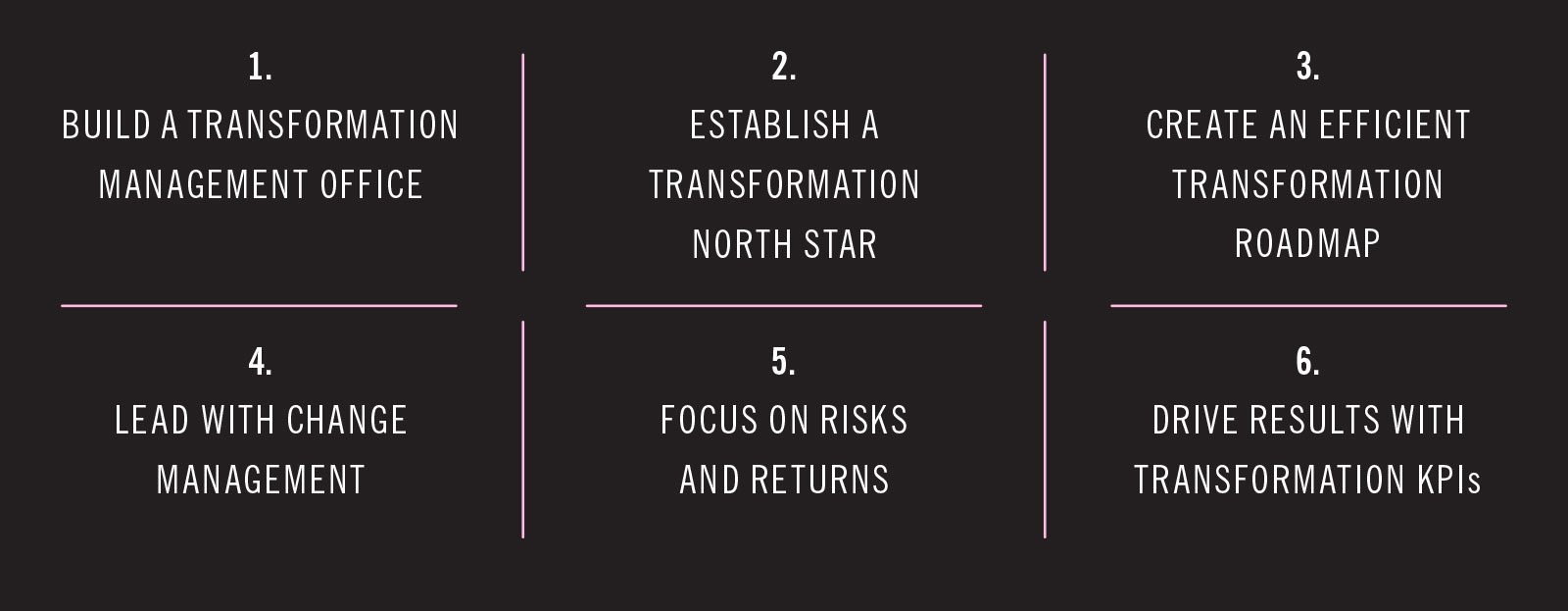Transformation success stats are abysmal. The CHAOS report has reported on technology project success rates for 30 years and has never reported a project success rate over 50 percent. This means the odds of technology success are, and have been for decades, worse than flipping a coin. The stress of big change is difficult, and market demands are complicated. The translation for today’s top executives: Transformation is hard.
Transformation is especially hard for leaders who are working toward new goals while also managing the stress of existing day-to-day operations, which often require hitting key performance indicators (KPIs), managing the churn of employees through the Great Resignation, and implementing major initiatives in the name of continuous improvement.
We’ve had the privilege of partnering with many executives on various consulting projects who are excellent at managing this delicate balance. We call them “drivers” because they lead their teams to the finish line on both transformational and operational needs. And we describe their journey as “changing tires on a moving car” because, well, that’s what it feels like. These skilled leaders create incredible change but never stop along the way.
We also discovered that their transformations were most successful when each driver executive followed a similar roadmap that included the same six steps:
- Build a Transformation Management Office
- Establish a Transformation North Star
- Create An Efficient Transformation Roadmap
- Lead With Change Management
- Focus on Risks and Returns
- Drive Results with transformation KPIs

1
Start Your Engine
BUILD A
TRANSFORMATION
MANAGEMENT
OFFICE
Transformation strategy becomes a transformation reality only when an executive team is accountable for transformation priorities. The TMO consists of a small group of action-oriented leaders who are change agents and understand that transformation is critical to organizational success. This “ride or die” mentality is required to relentlessly drive change through the entire process — from the vision to the multiyear roadmap to the front-line change necessary to truly create transformation.
Build your TMO by including top-level executives who can drive complex decision-making. Don’t apologize for excluding leaders who can’t support the transformation causes. Establish a single TMO leader who can maintain the roadmap and ensure critical items are both identified and resolved with a set cadence. The TMO leader’s mantra is “Have a bias for action,” and that bias for action needs to be actively taught and coached. Creating a step-change doesn’t happen overnight, and it doesn’t happen if you aren’t willing to take big steps forward.
2
Select Your Destination
ESTABLISH A
TRANSFORMATION
NORTH STAR
WHY IT MATTERS:
A Transformation North Star is about thinking big and then slowly dialing it back to match reality. The North Star must be ambitious enough to mobilize and excite your team but realistic enough to not create disappointment by being out of reach. Setting your North Star involves understanding the difference between a false promise that demoralizes and a big hairy audacious goal (BHAG) that creates a huge organizational win.
If you’re midtransformation, then you’ll want to use every initiative, user pain point, and goal/KPI that your team has outlined to build a cohesive North Star. If you’re just starting, however, focus on building a business case that clearly articulates your customer and employee values. In both cases, your Transformation North Star builds on existing values, but with an understanding that you are creating a new normal for the organization. Revenue increase and cost reduction are great, but don’t forget that the North Star must be visceral for the customer and employee. Focus on experiences that are “frictionless,” straightforward, and integrated.
Over the past
30 years, most
technology
projects have
fallen flat, with
a success rate
below 50 percent.

3
Set the GPS
CREATE AN
EFFICIENT
TRANSFORMATION
ROADMAP
WHY IT MATTERS:
In creating significant change, teams can easily disrupt customers and operations. If they’re not careful, each disruption can build on top of the other and create a significant negative impact. Therefore, the roadmap needs to carefully consider people and technology implementation efficiencies, including change burnout and stepping stones for technology improvements.
Set expectations for the business on day one by publishing the transformation roadmap. Ensure timelines are calibrated to the months or quarters when disruptions will be few and the business minimally impacted. Change impacts on the organization should be evaluated in terms of how much disruption can be absorbed right now, while executives should consider technology impacts in terms of steps taken to migrate to a target end-state platform. Careful consideration must also be given to choosing or updating software platforms, system architecture, and data lakes along with their respective integrations. The goal is to minimize time, cost, and rework by building the transformation as efficiently as possible.
4
Load the Passengers
LEAD WITH
CHANGE
MANAGEMENT
Change management for a transformation means first understanding the “What’s in it for me (WIIFM)?” views of your inside-the-car employees. From there, get inside the heads of your customers, suppliers, and vendors — those who are not in on the details of the change but will be impacted significantly and could walk away if their expectations aren’t met. Creating a customer journey map and documenting pain points is a minimum requirement to enable this understanding.
You’re inside the car, already thinking about adoption and usage combined with new ways of working. Set clear expectations for what adoption looks like (i.e., it gets worse before it gets better), what usage looks like (WIIFM), and what new ways of working look like in practice — and not just “care about the customer,” but “create raving online fans who leave us five-star reviews.” The transformations that differentiate themselves find adoring fans at every internal level of the organization and in diverse areas externally. Publish those case studies to promote both quick and ongoing wins.
5
Fill the Tank
FOCUS ON RISKS
AND RETURNS
While we already discussed change burnout, which is especially important during the peak of the business cycle, financial risks are as critical. If your engine overheats halfway through the transformation, not only is the business worse off, but significant change hesitancy can also set in with credibility risk. Change management talks a lot about quick wins, but those quick wins need to continue for the transformation’s duration.
It’s not enough to define the finish line. The transformation should define hard and soft benefits that will be delivered and actively managed along the way. Financial metrics that are clear and simple to measure should be reported and reviewed quarterly by the TMO, and adjustments should be swift. Similarly, if softer benefits that center on employee or customer sentiment are lagging, then prompt action should also be taken. Quarterly results are key to staying on track — you simply can’t manage risk effectively if you wait six to 12 months. When change and financial management come together to report positive results, it feels like you filled the gas tank with fuel.
6
Check Your Dash
DRIVE RESULTS WITH
TRANSFORMATION
KPIs
When it comes to transformation, the curves in the road necessitate a steady hand on the wheel. The driver executive can’t be on autopilot or cruise control. A transformation of the scale we are talking about has millions of dollars on the line, and managing return on investment is an active effort. Without dashboard indicators, transparency loss combines with accountability loss, and the transformation becomes much more difficult to manage. KPIs aren’t just a transformation goal, they’re the hard metrics leaders are incented to hit.
Don’t keep secrets. Set a policy that the transformation is open and public with only a few exceptions, such as selective costs of vendors and employees. Now go back to the North Star, business case, and financial management to ensure that goals cascade down to front-line teams. If you have a member of the transformation who doesn’t understand how their current team can measurably improve your efforts, then go back to the drawing board and make sure your KPIs cascade down to them. And finally, as major initiatives are launched, the TMO needs to monitor benefits realization to ensure each initiative delivers on the promised return on investment.
We know, transformation is hard. So, when we undergo significant change, we cannot be asleep at the wheel, and we cannot put on autopilot. Instead, focus on these executive success factors to make transformation leadership a reality.
